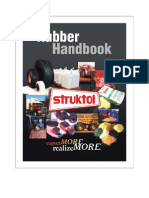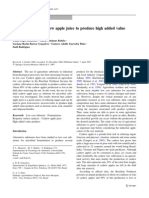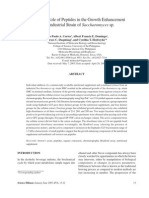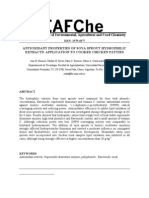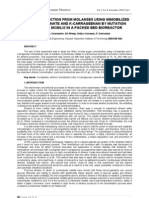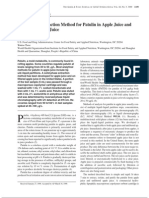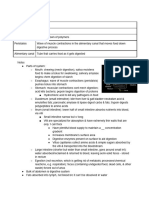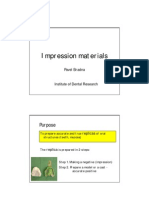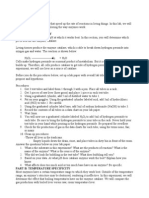Slide BIOPOLIMER
Slide BIOPOLIMER
Uploaded by
Jesa FradaCopyright:
Available Formats
Slide BIOPOLIMER
Slide BIOPOLIMER
Uploaded by
Jesa FradaCopyright
Available Formats
Share this document
Did you find this document useful?
Is this content inappropriate?
Copyright:
Available Formats
Slide BIOPOLIMER
Slide BIOPOLIMER
Uploaded by
Jesa FradaCopyright:
Available Formats
MICROBIAL BIOPOLYMER
1. Pullulan
2. Gellan Gum
3. Dextran
4. Xanthan Gum
Pullulan
Definition
Structure
Microorganism
Properties and quality parameters
Production and Downstream Process of
Pulullan
Pullulan derivatives
Application
Pullulan
Pullulan is a polysaccharide polymer
consisting of maltotriose units,
also known as -1,4- ;-1,6-glucan
Three glucose units in maltotriose are
connected by an -1,4 glycosidic bond,
whereas consecutive maltotriose units
are connected to each other by an -1,6
glycosidic bond.
Pullulan Structure
Optimum temperature : 26-28oC, pH 5 -6.5
Aureobasidium pullulan
Aureobasidium pullulan
Source of A. pullullans isolates
Wood
leather
hydrocarbons
synthetic materials
paper (paper, paper pulp)
human skin
paint (watercolours)
plants
food products (wheat, oats and bean seeds,
flours, fruits and vegetables, fruit juices)
soil
textile (cotton)
Aureobasidium pullulans
in leather (flesh)
Aureobasidium pullulans
in leather (grain)
Aureobasidium pullulans
(cotton)
Aureobasidium pullulans
in acidic paper
Growth curve of A. pullulan
On Malt-Agar growth medium
(MA) (pH 6.5)
On CYA growth medium (pH 5.5) Slimy
colonies (final pH 6).
On Czapek growth medium (initial pH
5.5 and final 5.5)
Properties and quality
parameters
1. Water soluble, insoluble in organic solvents, non
hygroscopic, aqueous solutions are stable and show a
relatively low viscosity compared to other
polysaccharides.
2. It decomposes at 250-280C. It forms easily, thermo-
stable, transparent, elastic, antistatic films, with an
extremely low oxygen permeability (compared to celofan,
polypropylene, polyesther, polyvinylchloride, etc)
3. Moldable, and spinnable, good adhesive and binder.
4. Non-toxic, edible, biodegradable and biocompatible.
Production and Downstream
Process of Pulullan in general
Submerged fermentation using carbohydrate as main media,
nitrogen source, minerals, temperature of 28o C, agitation
of 200 rpm
Downstream processing of fermentation broth includes :
biomass separation precipitation of filtrates by solvent
2- propanol concentration purification of solution
containing the pullulan-type polysaccharide ( partially
purified product or a highly-purified one modern
ultrafiltration techniques are used).
FERMENTATION STEPS
A.pululan in complex nitrogen
agar plates with 50 g/L sucrose
1
st
Media
propagation : malt
extract broth
2
nd
Media
propagation :
complex nitrogen
broth containing 50
g/L sucrose.
Fermentation
Centrifugation
and separation
of biomass
Precipitation of
pullulan by 2 propanol
followed by further
purification
Drying
Milling Packing
Examples of Pullulan Medium
Composition
Complex Nitrogen medium
5 g KH2PO4, 1 g NaCl, 0.6 g (NH4)2SO4, 0.2
g MgSO47H2O, 1 g yeast extract, 0.01 g
FeSO4, 0.01 g MnSO4 and 0.01 g ZnSO4 in
grams/liter of water
malt extract broth :20 g malt extract, 20 g
glucose and 1 g peptone per liter of water
(ATTC Medium 325).
Factors affecting pullulan
production
Media components
Strain of microorganisms
Characteristic of microorganism : the phylamentous
forms or chlamydospores are less productive than
the yeast or pigment-free blastospores (Audet et al.,
1996).
According to Shabtai and Mukmenev (1995), the
yeast-like cells did not produce much pullulan in the
presence of pigment, and the non pigmented swollen
blastospores or germinating blastospores help to
trigger the elaboration of pullulan
Commercial pullulan products
pullulan derivatives
Crosslinked pullulan microparticles
Carboxymethyl pullulan
Sulfopropyl pullulan
Pullulan acetate
Crosslinked pullulan
microparticles
Crosslinking reaction between pullulan and
epichlorohydrin followed by separation,
washing, drying
Healing of infected wounds
a b c
Treatment of a leg wound (horse) with crosslinked
pullulan microparticles: a) infected wound; b) wound
after several applications of crosslinked pullulan
microparticles; c) wound after 2 weeks of treatment.
Crosslinked pullulan microparticles in dry state
Application
edible films for food packaging
breath freshener or oral hygiene products
such as Listerine Cool Mint PocketPaks.
As a food additive, it is known by the E
number E1204 (e.g in cosmetics (hydrating
creams and gels)
filming agent in pharmaceutics (retard
tablets, capsules and microcapsules)
Entrap colours and flavours
Innovative use of pullulan film in
sugar confectionary
Effect of pullulan coating in tablet
Soft candy manufacturing
Pullulan capsules
Application (cont.)
Textiles industry (antistatic, in non-
woven)
Paper industry (coating, in composition)
Photosensible materials (emulsions)
Agriculture (low release fertilizers)
Metalurgy (foundery mold or casting)
Mining (floculant, binder).
Definition
Structure
Microorganism
Production and downstream process
Application
Gellan Gum
a water-soluble polysaccharide produced
by a bacterium Pseudomonas elodea
used primarily as a gelling agent,
alternative to agar in microbiological
culture.
MW : 500 000
Forming viscous solution, insoluble in
ethanol
Structure
The repeating unit of the polymer is a
tetrasaccharide which consists of two residues
of D-glucose and one of each residues of L-
rhamnose and D-glucuronic acid.
The tetrasacharide repeat has the following
structure:
[D-Glc(14)D-GlcA(14)D-Glc(14)L-
Rha(13)]n.
As it is evident from the formula the
tetrasacharide units are connected with each
other using an (13) glycosidic bond.
Molecular structure
Structure (cont.)
Microorganism
Pseudomonas elodea = Sphingomonas
elodea
The composition and structure of native
gellan gum produced by commercial
fermentation is identical to the naturally
occurring polysaccharide formed by
Sphingomonas elodea on plants of Lily
pad varieties.
Pseudomonas elodea
Sphingomonas
Gram-negative, rod shaped, chemo
heterotrophic,
strictly aerobic bacteria
containing glycosphingolipids (GSLs) in
their cell envelopes,
typically produce yellow-pigmented
colonies
Yellow pigmented colonies of
Sphingomonas
Properties of gellan gum
ability to suspend while contributing
minimal viscosity via the formation of a
uniquely functioning fluid gel solution
with a weak gel structure.
setting temperature, degree of structure
and thermal stability.
Water soluble
Biosynthesis
1. intracellular formation of the nucleotide-
sugar precursors, UDP-Glc, UDP-GlcA, and
dTDP-l-Rha.
2. formation of the repeat unit, with sequential
transfer of the sugar donors to an activated
lipid carrier by committed
glycosyltransferases
3. gellan polymerization
4. Export to outer of cells
Production and downstream
process in general
produced by a pure culture fermentation of
carbohydrates by Pseudomonas elodea,
purified by recovery with alcohol, dried, and
milled.
The direct fermentation of sweet cheese whey
diluted 1:5 with water resulted in production of
approximately 7 g of EPS (extra
polysaccharides Sellular ) gellan gum per liter
and in a 70% reduction in the initial BOD5
interesting valorisation of this waste of the
dairy industry and BOD reduction.
Factors affecting gellan gum
production
1. Media components
Molasses 112.5 g/L, tryptone 1 g/L,
casamino acid 1 g/L , disodium hydrogen
orthophosphate 1 g/L and manganese
chloride 0.947 g/L produced gellan
gum of 13.81 g/L
Factors affecting gellan gum
production (cont.)
2. Addition of precursor The sugar
nucleotides providing the activated
precursors for synthesis of
tetrasaccharide i.e UDP-glucose, TDP-
rhamnose and UDP-glucuronic acid.
3. Addition of amino acid triptophan
enhanced cell growth
4. pH 6.5 - 7
Factors affecting gellan gum
production (cont.)
5.Agitation rate : 250 rpm using a helical
ribbon impeller
6. Higher DOT (dissolved oxygen tension)
levels improve the viscosity and
molecular mass of the polymer
7. Temperature : 30oC
DOWNSTREAM PROCESS
Fermentation
broth
Heating 90-95oC, 10-15
min
Killed bacteria and reduced the viscosity
Dilution
Centrifugation and filtration
Separates cells and filtrates
Precipitation by alcohol
followed by centrifugation
Drying 55oC
Milling and packing of
crude gellan gum
Purification of gellan gum
After alcohol precipitation, the products are
washed repeatedly with acetone and ether,
dissolved in deionised water and dialyzed
against deionised water by using dialysis
tubing with molecular mass cut-off of 12 000
14 000.
After dialysis for 23 days with four or five
changes of deionised water, the solution was
lyophilized to formulate dry gellan powder
gel filtration chromatography (GFC) can also
be used
Application
Applications in foods : stabilizer,
emulsifier, thickener
Applications in pharmaceutical industry
Solid culture media for growth of
microorganisms and plants
Gel electrophoresis in biological
research
Cell immobilization
DEXTRAN
complex, branched glucan
(polysaccharide made of many glucose
molecules) composed of chains of
varying lengths
Dextran was first discovered by Louis
Pasteur as a microbial by product in
wine
Structure
The straight chain consists of -1,6
glycosidic linkages between glucose
molecules, while branches begin from -
1,4 linkages (and in some cases, -1,2
and -1,3 linkages as well).
molecular weights ranging from 10,000
Da to 150,000 Da.
Molecular Structure
Microorganisms
Dextran is synthesized from sucrose by
certain lactic-acid bacteria, the best-known
being Leuconostoc mesenteroides and
Streptococcus mutans, L. dextranicum , S.
salivarius, S. bovis
Dental plaque contains dextran
Leuconostoc mesenteroides Streptococcus mutans
Slimy dextran produced by Leuconostoc
mesenteroides CMG713 on sucrose
containing medium with 0.005 % sodium
azide
Production of dextran
Medium : using sucrose as carbon source, examples :
Sucrose 150.0 g., Peptone 2.5 g., Yeast extract 2.5 g.,
K2HPO4 , 5.0 g., NaCl 2.5 g., and a water extract of
sugar refining charcoal 2.0 ml.
Sucrose 150.0 g., acid hydrolyzed casein 5.0 g., Yeast
extract 1.0 g., K2HPO4 5.0 g., NaCl 2.0 g., and MgSO4
0.022 g.
(g l1): sucrose, 150.0; bacto-peptone, 5.0; yeast extract,
5.0; K2HPO4, 15.0; MnCl2.H2O, 0.01; NaCl, 0.01; CaCl2,
0.05.
Condition and downstream
process
Condition : 30 oC, 20 hours
Downstream process :
The culture medium after 20 hours was precipitated
using equal volume of chilled ethanol, shaken
vigorously, centrifuged at 10,000 rpm for 15 minutes
and the supernatant was decanted. This step was
repeated twice.
The precipitated dextran was dried under vacuum
over calcium chloride at 30C. The dextran yield was
calculated on dry weight basis.
Purification
For removal of impurities, dextran obtained
from precipitation was dissolved in distilled
water.
The dextran slurry was again precipitated with
equal volume of chilled ethanol. This
procedure of re-dissolving, precipitation and
washing was repeated three times to remove
cells debris.
Purified dextran was dried under vacuum over
calcium chloride at 30C
Factors affecting dextran
production
1. Incubation time
Factors affecting dextran
production (cont.)
2. Substrate concentration
Factors affecting dextran
production (cont.)
3. Temperature
Factors affecting dextran
production (cont.)
4. pH
Molecular weight of dextran types
using glass column chromatography
packed with Sepharose CL6B.
Remarks :
Blue Dextran, 2000,000;
Industrial dextran, 5000,000-40,000,000;
Dextran from Leuconostoc mesenteroides
CMG713, 5,000,000-20,000,000.
Application medical uses
eye drops as a lubricant
decrease vascular thrombosis.
Dextran in intravenous solution provides an
osmotically neutral fluid that once in the body is
digested by cells into glucose and free water.
It also increases blood sugar levels.
Other uses
size-exclusion chromatography matrices;
an example is Sephadex.
bead form to aid in bioreactor
applications (immobilization)
stabilizing coating to protect metal
nanoparticles from oxidation
make microcarriers for industrial cell
culture
Application (cont. )
GUM XANTHAN
ISI KULIAH :
1. Deskripsi Produk ( Sifat fisiko kimia, biosintesa ,
kegunaan dalam industri, dll)
2. Mikrooorganisme
3. Tahapan fermentasi
4. Proses Hilir (recovery)
5. Prospek Pengembangan
di Indonesia
Gum xanthan : eksopolisakarida mikrobial yang diproduksi
oleh Xanthomonas campestris dari bahan
berkarbohidrat
Sifat Fisiko Kimia :
1. Heteropolisakarida anionik yang bercabang
2. Mengandung D-glukosa (2.8 mol), D-manosa (3.0 mol),
D-glukuronat (2.0 mol), asam asetat dan asam piruvat
3. Rantai utama mirip kerangka selulosa (rantai glukosa
berikatan 1,4)
4. Rantai sisi mengandung dua unit manosa dan satu unit
asam glukuronat
5. Asetat dan piruvat berikatan pada ujung manosa
6. BM : 2-50 x 10
6
atau 3 x 10
7
dalton
Struktur molekul gum xanthan
TURUNAN KIMIA DAN KOPOLIMER CANGKOKAN GUM
XANTHAN
1. Gum Karboksimetil xanthan
2. Gum dietilaminotil xanthan
3. Ester propilenglikol xanthan
4. Gum xanthan sulfat
5. Ikatan silang aldehid gum xanthan
6. Gum deasetil xanthan
7. Gum xanthan - g poli akrilamida
Sampai saat ini tidak ada yang diproduksi secara komersil
SIFAT-SIFAT GUM XANTHAN :
1. Viskositas tinggi pada konsentrasi rendah,
2. Kekenyalan semu (pseudoplasticity) tinggi
3. Mudah larut dalam air panas maupun dingin
4. Viskositas larutan gum xanthan stabil terhadap suhu
5. Viskositas larutan gum xanthan stabil terhadap pH
6. Kelarutan dan kestabilan tinggi pada asam
7. Unggul dalam daya suspensi karena yield valuenya tinggi
8. Kesesuaian yang baik dengan berbagai garam
9. Stabilitas pada proses pelelehan dari keadaan bekunya
(freeze thaw)
SIFAT GUM XANTHAN (LANJUTAN)
10. Kompatibel terhadap beberapa pelarut seperti methanol,
ethanol, isopropanol dan aseton sampai konsentrasi 50-60
%. Konsentrasi pelarut > 60 % akan menyebabkan
gelatinisasi atau pengendapan gum xanthan
11. Tidak terdegradasi oleh enzim protease, selulase
hemiselulase, pektinase dan amilase, tetapi dapat
terdegradasi oleh pengoksidasi kuat seperti peroksida,
persulfat dan hipoklorit
12. Sinergi terhadap gum yang lain seperti gum guar, dan
gum dari biji locust (locust bean gum) serta galaktomanan
Viskositas (cp)
1000
100
0.5 1.0 1.5 2.0 2.5 3.0 Konsentrasi (%)
Pengaruh konsentrasi gum xanthan thd viskositas
Konsentrasi garam (NaCl) (%)
Viskositas (cP)
100
1000
0.01 0.05 0.1 1.0
0.1 % gum xanthan
0.25 % gum xanthan
0.5 % gum xanthan
1.0 % gum xanthan
Pengaruh konsentrasi garam thd viskositas lar gum xanthan
Temperatur (oF)
Viskositas (cP)
1000
10000
50 100 150 200
0.1 % gum xanthan
0.25 % gum xanthan
0.5 % gum xanthan
1.0 % gum xanthan
Pengaruh suhu thd viskositas lar gum xanthan
pH
Viskositas (cP)
1000
10000
1 3 5 7 9 11 13
0.1 % gum xanthan
0.25 % gum xanthan
0.5 % gum xanthan
1.0 % gum xanthan
Pengaruh pH thd viskositas lar gum xanthan
Viskositas (cP)
Laju geser detik
-1
0.1 1 10 100 1000 10 000
1
10
100
1000
10 000
100 000
1 000 000
0.5 %
1 %
2.5 %
Pengaruh laju geser terhadap viskositas larutan gum xanthan
Guar gum
Tara gum
Sifat sinergi gum xanthan dengan
polisakarida lainnya
APLIKASI DALAM INDUSTRI :
1. Industri Petroleum :
a. Sebagai cairan pelicin dalam pengeboran sumur minyak
b. Sebagai cairan untuk mengikat dan memisahkan garam-garam
dari hasil pengeboran minyak lepas pantai dari cairan petroleum
yang diinginkan
c. Sebagai cairan pemecah (fracturing fluid ) berbasis air
d. Untuk mempercepat pengambilan minyak (oil recovery)
Oil drilling
2. Industri Kimia dan lainnya
a. Pakan ternak : sebagai cairan pelengkap pakan (Liquid feed
supplements)
b. Flowable pesticides
c. Pewarnaan dan pengecatan tekstil
d. Pelapis keramik
e. Pembersih
f. Pensuspensi cairan tinta, cat dan perekat kertas
3. Industri Pharmasi dan Kosmetika :
a. Stabilizer emulsi cream untuk obat dan kosmetika
b. Pelarut cream dan lotion
c. Pensuspensi pasta gigi atau larutan pencuci gigi
4. Industri pangan :
a. Pastry filling
b. Penstabil saus dan kaldu
c. Pengemulsi dressing
d. Pengemulsi dan stabilizer dairy products
BIOSINTESA
Ada 4 jenis enzim yang terlibat :
1. Enzim untuk metabolisme awal substrat : hexokinase
2. Enzim untuk sintesis dan interkonversi nukleotida gula (UDP
glucose phosphorylase)
3. Enzim untuk pembentukan pengulangan unit polimer
(monosakarida) (transferase)
4. Enzim polimerase untuk pembentukan biopolimer
eksopolisakarida
Tahapan biosintesa :
1. Metabolisme substrat karbohidrat
2. Sintesis dan interkonversi nukleotida gula
3. Pengulangan unit monomer
4. Polimerisasi
MIKROORGANISME :
Bakteri penghasil gum xanthan :
Xanthomonas campestris
1. Gram Negatif
2. Membentuk koloni berlendir
berwarna kuning
3. Diisolasi dari daun/tanaman
yang berpenyakit,misalnya daun
kedelai yang terkena pustule,
daun kubis, tebu, dll
TAHAPAN FERMENTASI
Xanthomonas campestris
Pengembangan
inokulum
Tangki benih
Fermentasi
Pasteurisasi
dan
pemisahan
biomassa
Pengambilan
gum dengan
pelarut
Pengeringan
Penggilingan Pengemasan
Komponen media :
- Karbohidrat sbg sumber C
- Sumber N
- Mineral
- Antifoam
KONTROL PROSES
Level of control
Metabolic
Environmental Nutrients, pH, P O2, P CO2, shear, temperature, fluid properties
Equipment design
operation Nutrients, acid/base, antifoam addition, air flow, speed, over
pressure, coolant, flow rate and temperature, sparger, and fermenter
impeller geometry
Product biosynthesis
Cell environ
Other processes
Product
Waste (cells, other
products, heat)
SIFAT RHEOLOGI CAIRAN FERMENTASI GUM
XANTHAN SANGAT KHAS :
1. Pada penggunaan bioreaktor berpengaduk akan
timbul zona stagnasi
2. Masalah ini diatasi dengan penggunaan airlift
bioreactor
Air lift bioreactor
Stirred tank bioreactor
PROSES HILIR :
Cairan fermentasi
Pasteurisasi Untuk membunuh sel bakteri yang masih tersisa
Pengenceran
Untuk memudahkan pemisahan biomassa
karena kekentalannya telah diturunkan
Sentrifugasi
Untuk memisahkan sel/biomassa
Pengambilan gum dg pelarut Untuk mempresipitasikan gum , bisa dg
etanol, isopropanol, metanol, dll
Pengeringan
Penggilingan
BEBERAPA MERK GUM XANTHAN KOMERSIL :
1. Keltrol
2. Kelzan
3. Jungbunzlauer
4. Degussa
5. dll
Prospek Pengembangan di Indonesia :
1. Ketersediaan bahan baku : berbagai jenis sumber
karbon dan nitrogen
2. Ketersediaan sumber isolat
3. Aspek teknis teknologis (penggunaan teknologi
fermentasi)
4. Aspek pasar yang terbuka luas
You might also like
- Portland Cement: Standard Specification ForDocument16 pagesPortland Cement: Standard Specification ForJieying100% (3)
- Design and Sizing Calculation: Based On Api 521 Fourth Edition, March 1997 Horizontal Knockout Drum Data InputDocument2 pagesDesign and Sizing Calculation: Based On Api 521 Fourth Edition, March 1997 Horizontal Knockout Drum Data InputChitu Ionut Laurentiu100% (2)
- Rubber HandbookDocument146 pagesRubber HandbookLow Kah Zhoy100% (5)
- Microbial Biopolymer: Pullulan Gellan Gum Dextran Xanthan GumDocument93 pagesMicrobial Biopolymer: Pullulan Gellan Gum Dextran Xanthan GumDewi WijayantiNo ratings yet
- 4 PraveenDocument33 pages4 Praveenaneez2048No ratings yet
- Fermentation and Recovery of L-Glutamic - Acid - FromDocument8 pagesFermentation and Recovery of L-Glutamic - Acid - FromPrachi Bhoir100% (1)
- Bioconversion of Posthydrolysed Autohydrolysis Liquors: An Alternative For Xylitol Production From Corn CobsDocument8 pagesBioconversion of Posthydrolysed Autohydrolysis Liquors: An Alternative For Xylitol Production From Corn CobsMaria Victoria Ortega RamosNo ratings yet
- Xanthan Gum ProductionDocument6 pagesXanthan Gum ProductionAleem AhmedNo ratings yet
- Verde BrilhanteDocument2 pagesVerde BrilhanteMarcela OliveiraNo ratings yet
- Production of α-amylase using new strain of Bacillus polymyxa isolated from sweet potatoDocument7 pagesProduction of α-amylase using new strain of Bacillus polymyxa isolated from sweet potatoInternational Organization of Scientific Research (IOSR)No ratings yet
- Module 7 L3 Protease, Lipase, Glu OxidaseDocument4 pagesModule 7 L3 Protease, Lipase, Glu OxidaseVIRTUOUS GAMING 4 UNo ratings yet
- Thickening and Gelling AgentsDocument10 pagesThickening and Gelling AgentsHemasriNo ratings yet
- (Honorato Et Al., 2007) Fermentation of Cashew Apple Juice To Produce High Added Value ProductsDocument7 pages(Honorato Et Al., 2007) Fermentation of Cashew Apple Juice To Produce High Added Value ProductsRosane CavalcanteNo ratings yet
- Lutein Extraction An CVDocument22 pagesLutein Extraction An CVSacra PsyntergiaNo ratings yet
- Isolation and Characterization of Galactomannan From Sugar PalmDocument4 pagesIsolation and Characterization of Galactomannan From Sugar PalmRafaél Berroya Navárro100% (1)
- Ethanol CalculationDocument14 pagesEthanol CalculationMuhammad Azim Khan NiaziNo ratings yet
- Screening of Oleaginous Yeast Strains Tolerant To Lignocellulose Degradation CompoundsDocument14 pagesScreening of Oleaginous Yeast Strains Tolerant To Lignocellulose Degradation CompoundsJuanma AlfaroNo ratings yet
- Biodegradable Films: Based On Partially Hydrolyzed Corn Starch or Potato StarchDocument2 pagesBiodegradable Films: Based On Partially Hydrolyzed Corn Starch or Potato StarchUjak KimiaNo ratings yet
- Carbohydrates Face To Face ExperimentsDocument14 pagesCarbohydrates Face To Face ExperimentssilawanannamarieNo ratings yet
- Appl. Environ. Microbiol. 2008 Dumbrepatil 333 5Document3 pagesAppl. Environ. Microbiol. 2008 Dumbrepatil 333 5DHENADANo ratings yet
- Aplicacoes Bioiplasticos Polysaccharides NaturPlasDocument18 pagesAplicacoes Bioiplasticos Polysaccharides NaturPlasAlceu JuniorNo ratings yet
- GalactosidasaDocument8 pagesGalactosidasaMelissa SuárezNo ratings yet
- Starch Hydrolysis by AmylaseDocument9 pagesStarch Hydrolysis by Amylasegaurav saxenaNo ratings yet
- Microbial PolysaccharidesDocument6 pagesMicrobial PolysaccharidesAquib RazNo ratings yet
- Introduction and Formulation: Preparation of SuppositoryDocument52 pagesIntroduction and Formulation: Preparation of SuppositoryImam BisriNo ratings yet
- Chemistry Investigatory Project 12TH Bioplastic Out of Potato StarchDocument16 pagesChemistry Investigatory Project 12TH Bioplastic Out of Potato Starchst.8b.vedangrathodNo ratings yet
- Nanoencapsulation of Passion Fruit By-Products Extracts For Enhanced Antimicrobial ActivityDocument10 pagesNanoencapsulation of Passion Fruit By-Products Extracts For Enhanced Antimicrobial ActivityJavier R. AmayaNo ratings yet
- 4th Year Biotech Students Lab Practicals On Enzyme TechnologyDocument5 pages4th Year Biotech Students Lab Practicals On Enzyme TechnologyABU LoasNo ratings yet
- Gellan Gum Fermentative Production, DownstreamprocessingDocument14 pagesGellan Gum Fermentative Production, DownstreamprocessingM KaedeNo ratings yet
- BiogumDocument11 pagesBiogumkirshNo ratings yet
- Problem With Gelatin Containing FormulationsDocument12 pagesProblem With Gelatin Containing FormulationsshdphNo ratings yet
- Fermentum Aarnikunnas2003Document11 pagesFermentum Aarnikunnas2003Gabriel Márquez AravenaNo ratings yet
- Gellan. Food Applications PDFDocument13 pagesGellan. Food Applications PDFCamelia TincuNo ratings yet
- A Single-Host Fermentation Process For The Production of Avor Lactones From Non-Hydroxylated Fatty AcidsDocument10 pagesA Single-Host Fermentation Process For The Production of Avor Lactones From Non-Hydroxylated Fatty Acidsoki trisnaNo ratings yet
- Jam Processing - Effect of Pectin Replacement by Locust Bean Gum On Its CharacteristicsDocument12 pagesJam Processing - Effect of Pectin Replacement by Locust Bean Gum On Its CharacteristicsThảo PhạmNo ratings yet
- 5.Applied-Acid Tolerant - KenjiTanakaDocument8 pages5.Applied-Acid Tolerant - KenjiTanakaImpact JournalsNo ratings yet
- ArticleDocument12 pagesArticleJiang ZhangNo ratings yet
- A Possible Role of Peptides in The Growth Enhancement of An Industrial Strain of Saccharomyces Sp.Document8 pagesA Possible Role of Peptides in The Growth Enhancement of An Industrial Strain of Saccharomyces Sp.Albert DomingoNo ratings yet
- IJRTI2303037Document8 pagesIJRTI2303037vivekNo ratings yet
- Application Potential of Grapefruit Peel As Dye Sorbent Kinetics, Equilibrium and PDFDocument9 pagesApplication Potential of Grapefruit Peel As Dye Sorbent Kinetics, Equilibrium and PDFSaadi BadisNo ratings yet
- Gluconic AcidDocument11 pagesGluconic AcidpalkybdNo ratings yet
- Introduction To BioseparationsDocument5 pagesIntroduction To BioseparationsbaanniiNo ratings yet
- Acid WashingDocument7 pagesAcid WashingArinaAdilaNo ratings yet
- Pectin MediaDocument2 pagesPectin Mediasuresh_kumar16174475No ratings yet
- Isolation, Purification and Functional Characterization of Glucansucrase From Probiotic Lactobacillus Plantarum DM5Document11 pagesIsolation, Purification and Functional Characterization of Glucansucrase From Probiotic Lactobacillus Plantarum DM5NiharikaNo ratings yet
- Microencapsulation of Ethanol Extract Propolis by Maltodextrin and Freeze-Dried PreparationDocument7 pagesMicroencapsulation of Ethanol Extract Propolis by Maltodextrin and Freeze-Dried Preparationridwan rahman salehNo ratings yet
- Antioxidants AOACread FileDocument4 pagesAntioxidants AOACread FileZacariasNo ratings yet
- Industrial Production of Enzyme Protease PDFDocument25 pagesIndustrial Production of Enzyme Protease PDFAyushman Kumar BanerjeeNo ratings yet
- AGAR CHROMOCULT Merck Rebrand - 110426 - 1906Document6 pagesAGAR CHROMOCULT Merck Rebrand - 110426 - 1906Luz Katherine MartinezNo ratings yet
- Starch Hydrolysis by AmylaseDocument13 pagesStarch Hydrolysis by AmylaseNahusenay TewodrosNo ratings yet
- Lipase Separation Downstream ProcessDocument23 pagesLipase Separation Downstream ProcessSonia SnowvyNo ratings yet
- Antioxidant Properties of Soy SproutsDocument11 pagesAntioxidant Properties of Soy SproutsmemiromeroNo ratings yet
- Production of Ethanol From MolassesDocument5 pagesProduction of Ethanol From MolassesKrishna PotluriNo ratings yet
- KYBGLDocument13 pagesKYBGLWahyu Angga RizalNo ratings yet
- Extraction and Characterization of Gelatin: A Functional BiopolymerDocument4 pagesExtraction and Characterization of Gelatin: A Functional BiopolymerTrần Thị QuỳnhNo ratings yet
- Solid-Phase Extraction Method For Patulin in Apple Juice and Unfiltered Apple JuiceDocument6 pagesSolid-Phase Extraction Method For Patulin in Apple Juice and Unfiltered Apple JuiceLorena Gilabert GutiérrezNo ratings yet
- Andreslacueva2008 2 PDFDocument7 pagesAndreslacueva2008 2 PDFFauziana NurhanisahNo ratings yet
- Bioethanol Ecological Alternative To Toxic Fossil Fuels Corectata BTDocument8 pagesBioethanol Ecological Alternative To Toxic Fossil Fuels Corectata BTCiprian Nicolae PopaNo ratings yet
- Zou Yuchun, Luo Shanshan and Li WenkuiDocument6 pagesZou Yuchun, Luo Shanshan and Li WenkuiKumar SaurabhNo ratings yet
- Bacterii Celulozolitice PDFDocument6 pagesBacterii Celulozolitice PDFArisitica VinilescuNo ratings yet
- Simultaneous Analysis of Glycolipids and Phospholids Molecular Species in Avocado (Persea Americana Mill) FruitDocument11 pagesSimultaneous Analysis of Glycolipids and Phospholids Molecular Species in Avocado (Persea Americana Mill) FruitindahNo ratings yet
- Plant and Animal Bio-Chemistry - Including Information on Amino Acids, Proteins, Pigments and Other Chemical Constituents of Organic MatterFrom EverandPlant and Animal Bio-Chemistry - Including Information on Amino Acids, Proteins, Pigments and Other Chemical Constituents of Organic MatterNo ratings yet
- RTS-03A OYM (P1) Physics&ZoologyDocument20 pagesRTS-03A OYM (P1) Physics&Zoologymangalythakkar15807No ratings yet
- Troubleshooting Hot Gear DrivesDocument8 pagesTroubleshooting Hot Gear DrivesYuda SatriaNo ratings yet
- Spartan SD-20 MSDSDocument6 pagesSpartan SD-20 MSDSSkySupplyUSANo ratings yet
- Sample Question Paper Term IIDocument3 pagesSample Question Paper Term IIKafeel ShahNo ratings yet
- Mayonnaise Lab ReportDocument6 pagesMayonnaise Lab Reportapi-298392554100% (2)
- Modul EQA 2014Document102 pagesModul EQA 2014Nursyafika JasmiNo ratings yet
- Gas DehydrationDocument15 pagesGas DehydrationRama Krishna PillaNo ratings yet
- Chemical Kinetics - LectureDocument37 pagesChemical Kinetics - LectureEsmira Melić ŠutkovićNo ratings yet
- GAOHOU PH 0-14 Value Detect Sensor Module + Electrode Probe BNCDocument10 pagesGAOHOU PH 0-14 Value Detect Sensor Module + Electrode Probe BNCSapry EL GammalNo ratings yet
- Introduction To The Physics of Membranes: Christoph A. Haselwandter California Institute of Technology Cah77@caltech - EduDocument40 pagesIntroduction To The Physics of Membranes: Christoph A. Haselwandter California Institute of Technology Cah77@caltech - EduAlexandru-Adrian BrateiNo ratings yet
- IB Biology 6.1 Digestion NotesDocument3 pagesIB Biology 6.1 Digestion NotesivankaNo ratings yet
- Fosroc ProductCatalogue 2021Document98 pagesFosroc ProductCatalogue 2021afryansyahNo ratings yet
- Impression MaterialsDocument29 pagesImpression Materialslah_sane100% (1)
- Unit 2 - Proteins NotesDocument16 pagesUnit 2 - Proteins NotesPRIYA SHEETAK100% (1)
- Development and Validation of UV Spectrophotometric Method For Simultaneous Estimation of Metformin HCL and Repaglinide in Bilayer Tablet Dosage FormDocument6 pagesDevelopment and Validation of UV Spectrophotometric Method For Simultaneous Estimation of Metformin HCL and Repaglinide in Bilayer Tablet Dosage Formnish115862047No ratings yet
- Titanium Dioxide (Tio) Nanoparticles - XRD Analyses - An InsightDocument10 pagesTitanium Dioxide (Tio) Nanoparticles - XRD Analyses - An InsightSourav RoyNo ratings yet
- Manufacture, Storage and Import of Hazardous Chemical (Amendment) Rules, 2000Document21 pagesManufacture, Storage and Import of Hazardous Chemical (Amendment) Rules, 2000amolbhaNo ratings yet
- Varietal and Geographic Classification French Red Wines Terms Elements, Amino Acids and Aromatic AlcoholsDocument17 pagesVarietal and Geographic Classification French Red Wines Terms Elements, Amino Acids and Aromatic AlcoholsBogdan CioroiuNo ratings yet
- Bitumen BasicsDocument9 pagesBitumen BasicsHaswanth KolluNo ratings yet
- Enzyme Lab - Enzyme ExperimentDocument5 pagesEnzyme Lab - Enzyme ExperimenthunarsandhuNo ratings yet
- 1 - SCH3U 1.1 Nature of Atoms-2Document38 pages1 - SCH3U 1.1 Nature of Atoms-2Simon McCabeNo ratings yet
- Fresh and Clean Bio Max Safety Data SheetDocument2 pagesFresh and Clean Bio Max Safety Data SheetHka IsmailNo ratings yet
- 310 Beckmann RearrangementDocument7 pages310 Beckmann RearrangementHussain ShahidNo ratings yet
- Pump TypesDocument8 pagesPump Typesdmars123100% (2)
- Energy Storage For VehiclesDocument19 pagesEnergy Storage For VehiclesMiguel GuerreroNo ratings yet
- DRLA Parts and Set UpDocument8 pagesDRLA Parts and Set UpRobert DennisNo ratings yet
- Guía de Agua Pura - ELGA Pure Water Guide v1 0Document43 pagesGuía de Agua Pura - ELGA Pure Water Guide v1 0petertaboadaNo ratings yet


